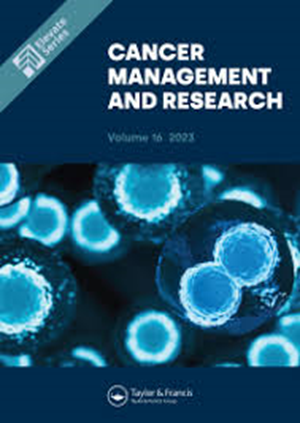The Effect of Intracranial Control After Intracranial Local Therapy on the Prognosis of Patients with Brain Metastasis of Lung Adenocarcinoma
IF 2.5
4区 医学
Q3 ONCOLOGY
引用次数: 0
Abstract
Purpose: The aim of the present study was to assess the clinical outcomes and prognostic factors of lung adenocarcinoma patients with brain metastases (BMs) after intracranial local therapy.Patients and Methods: A total of 83 lung adenocarcinoma patients with BMs who underwent craniotomy combined with radiotherapy or intracranial radiotherapy alone were retrospectively analyzed. The intracranial tumor response was determined according to the Response Assessment in Neuro-Oncology of Brain Metastases (RANO-BM) criteria. The median overall survival (OS), intracranial progression-free survival (iPFS), and related prognostic factors were analyzed with the Kaplan‒Meier estimator method and Cox proportional hazards regression model.
Results: Among 83 patients, 20 patients received craniotomy combined with radiotherapy, and 63 patients received intracranial radiotherapy alone. Following intracranial local therapy, 11 patients (13.3%) achieved complete response (CR); among them, 8 patients underwent neurosurgical resection. In addition, 32 patients (38.55%) achieved partial response (PR), 32 patients (38.55%) experienced stable disease (SD), and 8 (9.6%) experienced progressive disease (PD). The median follow-up period was 25.4 months (range 0.8– 49.6 months). The median follow-up time for the iPFS was 16.2 months (range 0.6– 41.2 months). The median OS, iPFS were 28.2 months and 24.7 months. Epidermal growth factor receptor (EGFR) / anaplastic lymphoma kinase (ALK) mutations (HR 3.216, 95% confidence interval (CI) 1.269– 8.150, p = 0.014) and iPFS (HR 0.881, 95% CI 0.836– 0.929, p < 0.001) were found to be beneficial factors for OS. An intracranial-tumor CR was associated with a longer iPFS (PR: HR 0.052, 95% CI 0.009– 0.297, p = 0.001; SD: HR 0.081, 95% CI 0.025– 0.259, p < 0.001; PD: HR 0.216, 95% CI 0.077– 0.606, p = 0.004).
Conclusion: Prolonged iPFS was associated with better OS in lung adenocarcinoma patients with BMs following intracranial local therapy, and mutations of EGFR / ALK or an intracranial-tumor CR are independent prognostic factors for prolonged survival.
Keywords: lung adenocarcinoma, brain metastases, intracranial local therapy, survival, prognostic factors
颅内局部治疗后颅内控制对肺腺癌脑转移患者预后的影响
目的:本研究旨在评估肺腺癌脑转移(BMs)患者接受颅内局部治疗后的临床疗效和预后因素:对83例接受开颅手术联合放疗或单纯颅内放疗的肺腺癌脑转移患者进行回顾性分析。颅内肿瘤反应根据脑转移瘤神经肿瘤学反应评估(RANO-BM)标准确定。中位总生存期(OS)、颅内无进展生存期(iPFS)及相关预后因素采用卡普兰-梅耶估计法和Cox比例危险回归模型进行分析:在83例患者中,20例患者接受了开颅手术联合放疗,63例患者仅接受了颅内放疗。颅内局部治疗后,11 名患者(13.3%)获得了完全反应(CR),其中 8 名患者接受了神经外科切除术。此外,32 名患者(38.55%)获得部分反应(PR),32 名患者(38.55%)病情稳定(SD),8 名患者(9.6%)病情进展(PD)。中位随访时间为 25.4 个月(0.8-49.6 个月)。iPFS的中位随访时间为16.2个月(0.6- 41.2个月)。OS 和 iPFS 的中位数分别为 28.2 个月和 24.7 个月。研究发现,表皮生长因子受体(EGFR)/无性淋巴瘤激酶(ALK)突变(HR 3.216,95% 置信区间(CI)1.269- 8.150,p = 0.014)和iPFS(HR 0.881,95% CI 0.836- 0.929,p <0.001)是影响OS的有利因素。颅内肿瘤CR与iPFS的延长有关(PR:HR 0.052,95% CI 0.009- 0.297,p = 0.001;SD:HR 0.081,95% CI 0.025- 0.259,p <0.001;PD:HR 0.216,95% CI 0.077- 0.606,p = 0.004):iPFS延长与颅内局部治疗后脑转移肺腺癌患者较好的OS相关,EGFR/ALK突变或颅内肿瘤CR是延长生存期的独立预后因素。
本文章由计算机程序翻译,如有差异,请以英文原文为准。
求助全文
约1分钟内获得全文
求助全文
来源期刊

Cancer Management and Research
Medicine-Oncology
CiteScore
7.40
自引率
0.00%
发文量
448
审稿时长
16 weeks
期刊介绍:
Cancer Management and Research is an international, peer reviewed, open access journal focusing on cancer research and the optimal use of preventative and integrated treatment interventions to achieve improved outcomes, enhanced survival, and quality of life for cancer patients. Specific topics covered in the journal include:
◦Epidemiology, detection and screening
◦Cellular research and biomarkers
◦Identification of biotargets and agents with novel mechanisms of action
◦Optimal clinical use of existing anticancer agents, including combination therapies
◦Radiation and surgery
◦Palliative care
◦Patient adherence, quality of life, satisfaction
The journal welcomes submitted papers covering original research, basic science, clinical & epidemiological studies, reviews & evaluations, guidelines, expert opinion and commentary, and case series that shed novel insights on a disease or disease subtype.
 求助内容:
求助内容: 应助结果提醒方式:
应助结果提醒方式:


